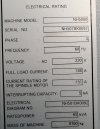I guess if you limit the time it's on. I "think", if you run it full time, you'll get about a week based upon calculations I've done in the past while ruminating on it.
It's not an inexpensive solution, but my wife (and dog) would certainly love me more if I decide to just go for it.
Also a consideration to have both, whole house AND the small ~2-3kwatt inverter generators (Honda and Yamaha are the gold standards, but I've heard the Predator gennies are decent and ~1/2 the price).
Those things are a lot more efficient for lighter/smaller loads, especially if you rotate their use for necessities (when you have no idea how long it msy take to restore power). Eg. Use it to power the refrigerator for an hour or 2, then a separate freezer for an hour or 2, to preserve the food in them vs burning fuel to power the whole house. The bigger the generator, the more fuel it tends to burn while running, even with little to no load.
You can increase your power utility/efficiency even more by pairing the generators with something like Sensorpush temperature sensors. You can purchase the sensors and use them with any smartphone via Bluetooth. Stick 'em in the fridge/freezer to monitor the temperatures.
Each battery powered sensor continually logs readings (every 30 seconds?) and retains the logs internally for a rolling 2 weeks or a month (can't quite recall). You can even setup the SensorPush app in your phone to sound an alarm (as long as the phone is within Bluetooth range) if the temperature or humidity readings exceed your chosen alarm setpoints.
I wound up also adding the Wifi Gateway. As long as the Gateway has power and the Wifi is working, I'll get alerts/alarms anywhere my phone can receive data (eg. If the fridge/freezer door is inadvertently left ajar and the temps climb above the alarm point, my phone will sound an alarm/alert while I'm out, at work, or even if I'm out of the state).
You can move these around and log different things, eg. Just how long it takes to cool the internal temps in the freezer to X, and how long it takes the temps to climb back up to XX, so you can optimize the power rotation/cycling for maximum fuel efficiency during an extended outage.

